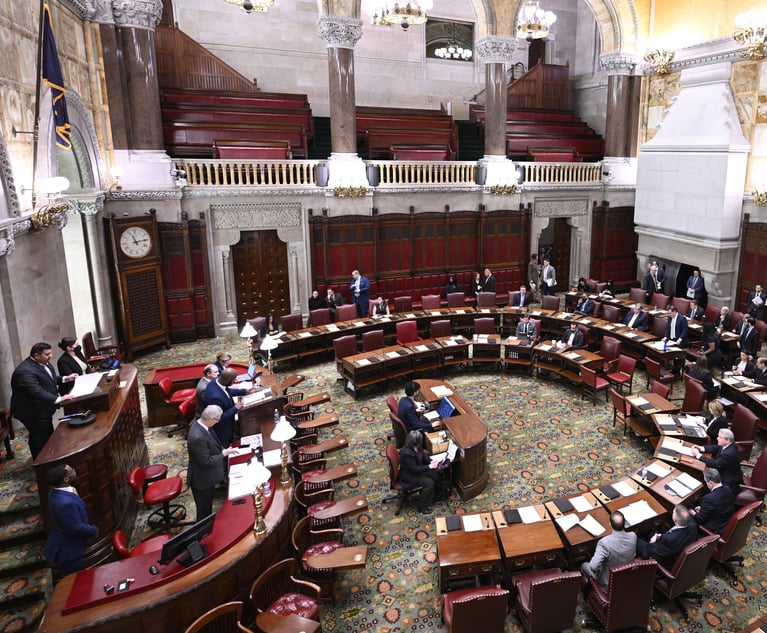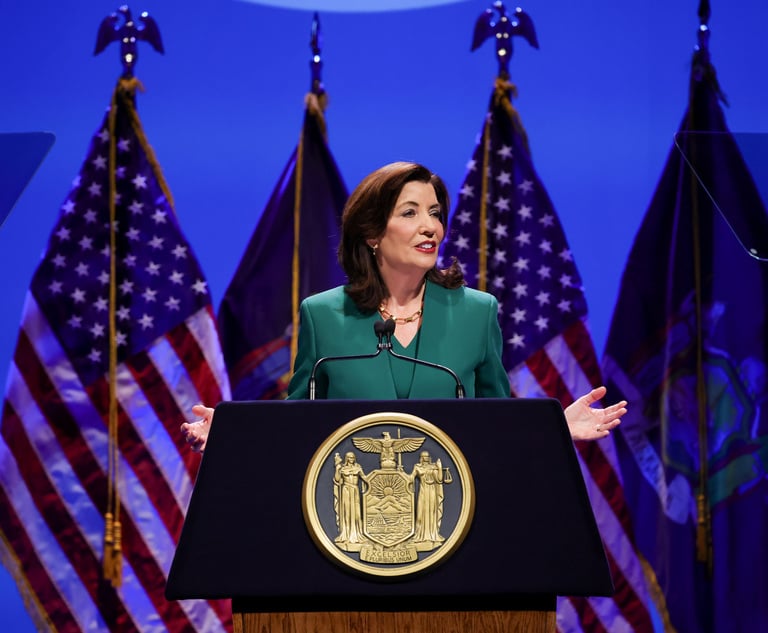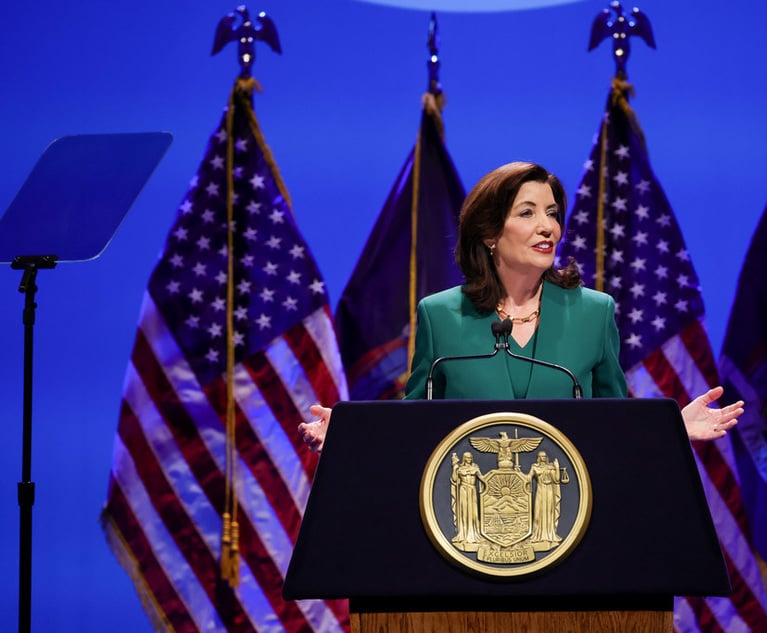Panel Hears Broad Support for Continued Parity Between State, Federal Judicial Salaries at Public Hearing
Chief Administrative Judge Lawrence Marks testified before a statewide panel tasked with setting those salaries that the court system is prepared to front the cost of those raises.
November 04, 2019 at 05:16 PM
7 minute read
 Chief Administrative Judge Lawrence K. Marks of the Courts of New York State (Photo/Hans Pennink)
Chief Administrative Judge Lawrence K. Marks of the Courts of New York State (Photo/Hans Pennink)
State judges in New York could receive an annual pay hike over the next four years under a proposal Monday from the state Office of Court Administration, which recommended that those salaries continue to be tied to wages earned by their counterparts in the federal court system.
Chief Administrative Judge Lawrence Marks testified before a statewide panel tasked with setting those salaries that the court system is prepared to front the cost of those raises.
"We will fully absorb the cost of those [cost-of-living adjustments] in our operating budget," Marks said.
The New York State Commission on Legislative, Judicial and Executive Compensation held the first of two public hearings Monday on whether judges paid by the state should receive a salary increase in the coming years, and how much that raise should be.
The panel is scheduled to publish a report in December that's set to determine how much judges in New York will be paid until their salaries are evaluated again in 2023.
That report will carry the force of law, meaning the state Legislature won't have to pass additional legislation to enact its recommendations next year. Lawmakers have the option to invalidate the report, but that hasn't happened in the past.
There was broad agreement among those who testified Monday, including Marks, that the salaries of state judges in New York should continue to be tied to what those in the federal judiciary earn.
That's the current model, as was established the last time salaries of state-paid judges were evaluated in 2015. The Commission on Legislative, Judicial and Executive Compensation decided, at the time, to enforce parity between the pay of state and federal trial court judges.
Under that model, the salary paid to state Supreme Court justices, who preside over cases in the lowest tier of the state court system, is required to match that of U.S. District Court judges, who share a comparable position in the federal judiciary.
Because of that agreement on parity, state Supreme Court justices and U.S. District Court judges both currently earn $210,900.
That's up from last year when their annual salary reached $208,000. Federal judges can be given raises based on changes to the cost of living. When those judges are given a pay hike, the state's current model requires the same increase for state Supreme Court justices.
That would continue if the state decides to maintain the same model for the next four years, as Marks proposed Monday.
"It's critically important that parity continue between the federal judges and the New York state judges," Marks said. "There's really no legitimate or rational reason why it should not, and the cost of doing so is extremely modest, is negligible, and is a cost that the court system will fully absorb in its budget."
If that model remains, and if the rate of pay were to increase over the next four years for state Supreme Court justices, the salaries of other judges presiding over state courts would also go up under the proposal.
That's because the salaries of other judicial positions within the state court system are tied to what's earned by state Supreme Court justices. Judicial salaries in state courts currently range from $189,900 to $240,800 each year.
The salary earned by state Supreme Court justices is the baseline for what all other judges earn within the state court system. And because those salaries are tied to the federal judiciary, so are the wages earned by all state judges in New York.
New York City Civil and Criminal Court judges, for example, earn 93% of whatever is paid to state Supreme Court justices in New York. City Court judges outside New York City earn 90% of the salary paid to a state Supreme Court justice.
Comparable formulas are used to determine the salary paid to judges in the higher tiers of New York's courts as well.
An associate justice on the Court of Appeals, the state's highest court, is currently paid $233,400. An associate justice of the Appellate Division, the state's intermediate court, earns $222,200. Those salaries have grown in proportion to the pay of state Supreme Court justices.
State judges would only be paid more in future years, under the OCA's plan, if federal judges are also scheduled to receive an increase.
"So, in other words if the federal judges get a cost-of-living adjustment over the next four years, that New York would get the same," Marks said.
Based on raises received over the last four years by federal judges, Marks said OCA has estimated an annual cost of the raises at about $3 million. He said that was less than one-eighth of 1% of the state court system's operating budget, which he expected them to fully absorb.
Support for continuing the model was also heard by others who testified at the hearing Monday, including New York City Bar Association President Roger Juan Maldonado, a partner at Smith, Gambrell & Russell.
"We must make sure to keep moving forward, to maintain that parity and continue to support adequate compensation for our colleagues on the bench because they are the backbone of a fair, effective and efficient judicial system," Maldonado said.
Queens County Supreme Court Justice Janice Taylor, the current president of the Supreme Court Justices Association of the City of New York, testified that Chief Judge Janet DiFiore's Excellence Initiative, launched to reduce court backlog, has also boosted performance among the state's judiciary.
With state courts operating more efficiently than in recent years, Taylor testified that parity with the federal judiciary should be preserved based on that workload.
"Our performance merits this level of compensation," Taylor said. "All of the performance indicators, including the standards and goals for the judiciary, evidence an extremely high level of performance by our judges in case management and disposition."
The proposal from OCA doesn't apply to town and village justices, whose salaries are not determined by the Commission on Legislative, Judicial and Executive Compensation. Their pay is locally funded and set within their jurisdiction.
The commission's binding report is scheduled to be released by the end of the year.
READ MORE:
Salaries of NY State Supreme Court Justices Now on Par With Federal Court Judges
Access to Civil Legal Services Has Grown, But More Funding Could Help, Attorneys Say
State Drops Appeal of Decision Striking Down Pay Raises, Outside Income Cap for Legislature
This content has been archived. It is available through our partners, LexisNexis® and Bloomberg Law.
To view this content, please continue to their sites.
Not a Lexis Subscriber?
Subscribe Now
Not a Bloomberg Law Subscriber?
Subscribe Now
NOT FOR REPRINT
© 2025 ALM Global, LLC, All Rights Reserved. Request academic re-use from www.copyright.com. All other uses, submit a request to [email protected]. For more information visit Asset & Logo Licensing.
You Might Like
View All
Federal Judge Pauses Trump Funding Freeze as Democratic AGs Plan Suit
4 minute read
Relaxing Penalties on Discovery Noncompliance Allows Criminal Cases to Get Decided on Merit
5 minute read
Bipartisan Lawmakers to Hochul Urge Greater Student Loan Forgiveness for Public-Interest Lawyers

'Playing the Clock'?: Hochul Says NY's Discovery Loophole Is to Blame for Wide Dismissal of Criminal Cases
Trending Stories
Who Got The Work
J. Brugh Lower of Gibbons has entered an appearance for industrial equipment supplier Devco Corporation in a pending trademark infringement lawsuit. The suit, accusing the defendant of selling knock-off Graco products, was filed Dec. 18 in New Jersey District Court by Rivkin Radler on behalf of Graco Inc. and Graco Minnesota. The case, assigned to U.S. District Judge Zahid N. Quraishi, is 3:24-cv-11294, Graco Inc. et al v. Devco Corporation.
Who Got The Work
Rebecca Maller-Stein and Kent A. Yalowitz of Arnold & Porter Kaye Scholer have entered their appearances for Hanaco Venture Capital and its executives, Lior Prosor and David Frankel, in a pending securities lawsuit. The action, filed on Dec. 24 in New York Southern District Court by Zell, Aron & Co. on behalf of Goldeneye Advisors, accuses the defendants of negligently and fraudulently managing the plaintiff's $1 million investment. The case, assigned to U.S. District Judge Vernon S. Broderick, is 1:24-cv-09918, Goldeneye Advisors, LLC v. Hanaco Venture Capital, Ltd. et al.
Who Got The Work
Attorneys from A&O Shearman has stepped in as defense counsel for Toronto-Dominion Bank and other defendants in a pending securities class action. The suit, filed Dec. 11 in New York Southern District Court by Bleichmar Fonti & Auld, accuses the defendants of concealing the bank's 'pervasive' deficiencies in regards to its compliance with the Bank Secrecy Act and the quality of its anti-money laundering controls. The case, assigned to U.S. District Judge Arun Subramanian, is 1:24-cv-09445, Gonzalez v. The Toronto-Dominion Bank et al.
Who Got The Work
Crown Castle International, a Pennsylvania company providing shared communications infrastructure, has turned to Luke D. Wolf of Gordon Rees Scully Mansukhani to fend off a pending breach-of-contract lawsuit. The court action, filed Nov. 25 in Michigan Eastern District Court by Hooper Hathaway PC on behalf of The Town Residences LLC, accuses Crown Castle of failing to transfer approximately $30,000 in utility payments from T-Mobile in breach of a roof-top lease and assignment agreement. The case, assigned to U.S. District Judge Susan K. Declercq, is 2:24-cv-13131, The Town Residences LLC v. T-Mobile US, Inc. et al.
Who Got The Work
Wilfred P. Coronato and Daniel M. Schwartz of McCarter & English have stepped in as defense counsel to Electrolux Home Products Inc. in a pending product liability lawsuit. The court action, filed Nov. 26 in New York Eastern District Court by Poulos Lopiccolo PC and Nagel Rice LLP on behalf of David Stern, alleges that the defendant's refrigerators’ drawers and shelving repeatedly break and fall apart within months after purchase. The case, assigned to U.S. District Judge Joan M. Azrack, is 2:24-cv-08204, Stern v. Electrolux Home Products, Inc.
Featured Firms
Law Offices of Gary Martin Hays & Associates, P.C.
(470) 294-1674
Law Offices of Mark E. Salomone
(857) 444-6468
Smith & Hassler
(713) 739-1250






